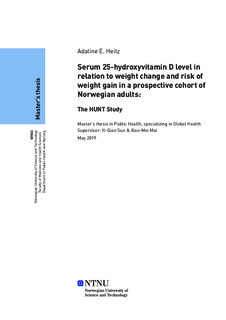| dc.description.abstract | Introduction: Overweight and obesity have long been associated with a variety of adverse health outcomes. In recent years, these health concerns have risen to epidemic proportions worldwide. Meanwhile, low vitamin D status remains a potential threat to health globally. Although cross-sectional studies have indicated an association between low vitamin D status and obesity, the longitudinal association between vitamin D status and weight change remains unclear. We sought to investigate the relationship of serum 25-hydroxyvitamin D [25(OH)D] levels with weight change and risk of weight gain in an adult population after 11 years of followup.
Methods: This prospective study included 1,501 adults who participated in the second and third surveys of the Nord-Trøndelag Health Study [HUNT2 (1995-1997) and HUNT3 (2006-2008)] in Norway. They were ≥19 years of age and had a normal body mass index (BMI ≥18.5 and <25 kg/m2) at baseline. Serum 25(OH)D levels were determined at baseline and classified as <25, 25.0-49.9, 50.0-74.9, and ≥75 nmol/L. Comprehensive lifestyle and anthropometric data were collected at baseline and follow-up. Percentage annual weight change was calculated using participant weight change and follow-up time between HUNT2 and HUNT3. Annual weight gain was defined as percentage annual weight change >1.25%, while clinical weight gain was defined as weight change ≥5% over follow-up. Adjusted coefficients and 95% confidence intervals (CI) for the association of baseline 25(OH)D level with percentage annual weight change were estimated using multivariable linear regression. Multivariable logistic regression models were used to estimate adjusted odds ratios (OR) and 95% CIs for risk of annual weight gain and risk of clinical weight gain. We evaluated effect modification by sex, age, and physical activity for risk of clinical weight gain.
Results: Over the follow-up period, a reduction in percentage annual weight change seemed to be present but not statistically significant as 25(OH)D increased by 25 nmol/L increments (coefficient = -0.05, 95% CI: -0.11–0.01). In total, 201 participants experienced annual weight gain (13.4%) and 708 experienced clinical weight (47.2%). Risk of annual weight gain and risk of clinical weight gain were significantly reduced in the 25(OH)D ≥75 nmol/L group compared with the <25 nmol/L group (OR=0.32, 95% CI: 0.12–0.87 and OR=0.46, 95% CI: 0.22–0.97, respectively), and a dose-response relationship was observed between 25(OH)D levels and both outcomes. The association of 25(OH)D with risk of clinical weight gain appeared stronger in female and low physical activity participants compared with male and high physical activity participants (OR=0.70 vs. 1.00 and 0.65 vs. 0.91, respectively). There was no effect modification by age.
Conclusion: These findings suggested an association of serum 25(OH)D levels with weight change and risk of weight gain. The association appeared to differ by sex and physical activity. Given the prevalence and wide-ranging health effects of both obesity and vitamin D deficiency, the link between vitamin D status and body weight should be considered in public health efforts.
Keywords: obesity; weight change; weight gain; 25-hydroxyvitamin D; vitamin D; HUNT; prospective studies | |
